CV-9 Essex Class Aircraft Carriers

CV-9 Essex Class carriers played a major role in U.S. naval history. These ships helped our country win in the Pacific Theater during World War II. Until super carriers were built in the 1960s and 1970s, reconstructed CV-9 Essex Class carriers continued to serve as the Navy’s premier aircraft carriers.
History of Essex Class Carriers
After Japan abrogated disarmament treaties in 1936, the U.S. re-evaluated its naval strength and the Naval Expansion Act of Congress was passed in May of 1938. The act authorized additional aircraft carrier tonnage for the Navy’s fleet.
With naval treaty restrictions lifted, larger aircraft carriers could be constructed. The CV-9 was the prototype of the new 27,000 ton carriers. Although 32 Essex Class carriers were ordered in 1940, only 24 were completed.
Three were ordered in June 1940 and ten more in July 1940. An additional 19 were authorized in 1942. Orders for CV-50 to CV-55 were canceled, however, in 1945. In 1943 the completed CV class carriers were ready for action.
Originally ordered into combat in 1944, the carriers were sent to the fleet ahead of schedule after U.S. losses at Midway, Coral Sea, and the Solomons in the Pacific. On the last day of 1942, Essex (CV-9) joined the fleet.
Yorktown (CV-10), Frankin (CV-13), Ticonderoga (CV-14), Randolph (CV-15), Lexington (CV-16), Bunker Hill (CV-17), Intrepid (CV-11), Wasp (CV-18), Hornet (CV-12), Hancock (CV-19), Bennington (CV-20), Boxer (CV-21), Bon Homme Richard(CV-31), Leyte (CV-32), Kearsarge (CV-33), Oriskany (CV-34), Antietam(CV-36), Princeton (CV-37), Shangri-La (CV-38), Lake Champlain (CV-39), Tarawa (CV-40), Valley Forge (CV-45), and Philippine Sea (CV-47) followed in January through November 1943.
None of these carriers were lost in action during World War II, but several sustained severe damage from Kamikazes. After a number of reconstruction programs the Essex Class carriers served the U.S. Navy for nearly 50 years as the core of the post-war fleet.
Essex Class Technical Specs
Essex Class carriers have been modified in various post-war reconstruction programs. Their technical specifications, before and after modifications, are as follows:
- Length: 872 ft. (original); 910 ft. (modified)
- Displacement: 27,100 tons (original); 41,200 tons fully loaded (modified)
- Beam: 147’ 6”
- Draft: 28’ 7”
- Flight deck width: 191.9’
- Crew: 2,631 to 3,448
- Speed: 33 knots
- Propulsion system: 8 boilers, 4 steam turbines, 4 propellers
- Aircraft elevators: 3
- Arresting cables: 4
- Planes: 80 to 100
Sources:
- Global Security.org: CV-9 Essex Class
- FAS Military Analysis Network: CV-9 Essex Class
- Navy Site: USS Essex (CV-9)
- USS Essex CV-9 Aircraft Carrier
